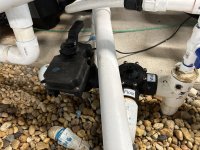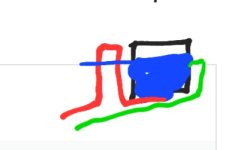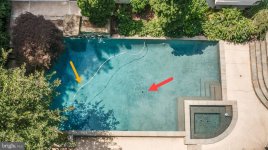My former pool guy plumbed in my salt cell without adapting the pipes or valves, rather he just separated the pool return line and plumbed it in using 6 90 degree elbows. It's quite a mess, I can't even access the floor/wall valve below with its handle. What he built is not very well supported and oscillates slightly. I just upgraded from a 1.65 HP pump to a 2.7 HP pump & I am worried the new pump will blow that mess right off the system.
I have a shared heater for 2 separate bodies with 2 separate pumps, so that is the reason for the busy interchange of pipes.
I am thinking to raise the lower pool diverter valves above the spa piping and turning the waterfall diverter valve around180 degrees so the return off the salt cell can go directing into it thus eliminating the last 2 elbows. With the pool pipes higher, they can feed directly into the salt cell eliminating the first 2 elbows. Thus I will go from 6 to 2 elbows in that path.
I will replumb with all sweep elbows. I am going to clean up other pipes too; there had been an autofill that was essentially directly connected to the household water supply which I deleted and I am going to move the polaris feed off the wall return and place it at the pool filter exit. Also going to eliminate an elbow on the heater return by changing the pipe path.
I am thinking to replace both the waterfall diverter valve and the pool floor/wall diverter valve while I am doing all this. On the pool pipes, there are a couple small plugs from whatever was connected. I know there was the old school chlorinator with the black hose on one.
Is it trivial to plug main drains and start such a job? I don't want to empty my 35,000+ gallon pool into the pool room to save whatever it would cost to pay someone because a plug wasn't secured. I am not even opposed to paying, but in my area, good pool service is hard to come by. Thanks in advance.
I have a shared heater for 2 separate bodies with 2 separate pumps, so that is the reason for the busy interchange of pipes.
I am thinking to raise the lower pool diverter valves above the spa piping and turning the waterfall diverter valve around180 degrees so the return off the salt cell can go directing into it thus eliminating the last 2 elbows. With the pool pipes higher, they can feed directly into the salt cell eliminating the first 2 elbows. Thus I will go from 6 to 2 elbows in that path.
I will replumb with all sweep elbows. I am going to clean up other pipes too; there had been an autofill that was essentially directly connected to the household water supply which I deleted and I am going to move the polaris feed off the wall return and place it at the pool filter exit. Also going to eliminate an elbow on the heater return by changing the pipe path.
I am thinking to replace both the waterfall diverter valve and the pool floor/wall diverter valve while I am doing all this. On the pool pipes, there are a couple small plugs from whatever was connected. I know there was the old school chlorinator with the black hose on one.
Is it trivial to plug main drains and start such a job? I don't want to empty my 35,000+ gallon pool into the pool room to save whatever it would cost to pay someone because a plug wasn't secured. I am not even opposed to paying, but in my area, good pool service is hard to come by. Thanks in advance.

















